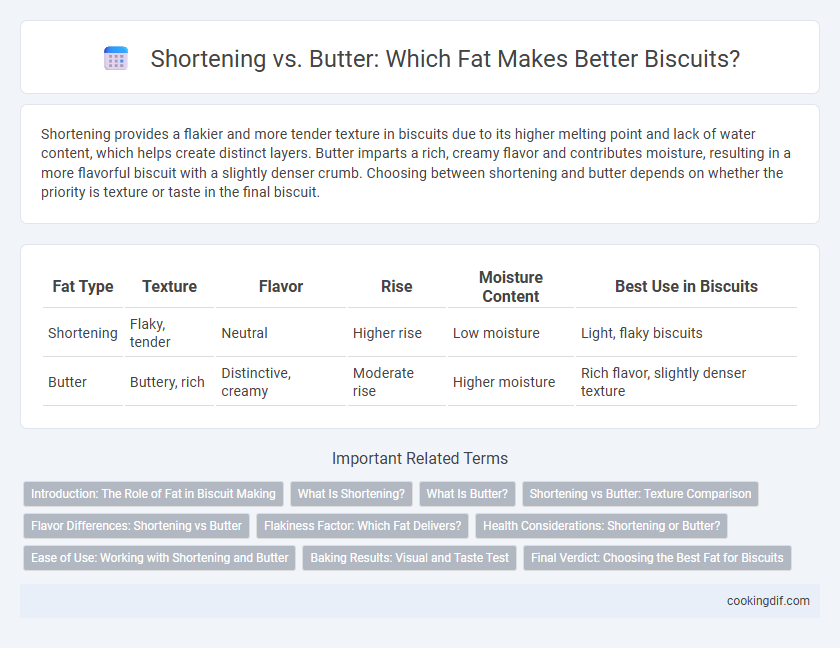Shortening provides a flakier and more tender texture in biscuits due to its higher melting point and lack of water content, which helps create distinct layers. Butter imparts a rich, creamy flavor and contributes moisture, resulting in a more flavorful biscuit with a slightly denser crumb. Choosing between shortening and butter depends on whether the priority is texture or taste in the final biscuit.
Table of Comparison
| Fat Type | Texture | Flavor | Rise | Moisture Content | Best Use in Biscuits |
|---|---|---|---|---|---|
| Shortening | Flaky, tender | Neutral | Higher rise | Low moisture | Light, flaky biscuits |
| Butter | Buttery, rich | Distinctive, creamy | Moderate rise | Higher moisture | Rich flavor, slightly denser texture |
Introduction: The Role of Fat in Biscuit Making
Fat in biscuit making plays a crucial role in creating tender, flaky textures by coating flour proteins and inhibiting gluten development. Shortening, a solid fat made from vegetable oils, provides a higher melting point which contributes to a lighter, flakier biscuit structure. Butter offers rich flavor and moisture but contains water content that can affect dough consistency and produce a denser crumb.
What Is Shortening?
Shortening is a solid fat made from vegetable oils, often used in biscuit recipes to create a tender, flaky texture by inhibiting gluten formation. It has a higher melting point than butter, which helps biscuits maintain their shape and rise better in the oven. Unlike butter, shortening contains no water, resulting in a more consistent crumb and longer shelf life for baked goods.
What Is Butter?
Butter is a dairy product made by churning cream to separate the fat from the buttermilk, containing about 80% fat, predominantly saturated fat. It provides a rich flavor and contributes to a tender, flaky texture in biscuits by trapping steam during baking. Unlike shortening, butter offers natural moisture and browning properties, enhancing both taste and appearance.
Shortening vs Butter: Texture Comparison
Shortening produces biscuits with a tender, flaky texture due to its higher melting point and pure fat content that creates distinct layers during baking. Butter contributes a richer flavor and a slightly denser, crumbly texture because of its water content and lower melting point. Choosing shortening over butter results in lighter, flakier biscuits, while butter offers a more flavorful but less airy crumb.
Flavor Differences: Shortening vs Butter
Butter imparts a rich, creamy flavor and a slightly sweet aroma to biscuits, enhancing their overall taste profile. Shortening, on the other hand, produces a more neutral flavor, allowing other ingredients to stand out while contributing to a tender, flaky texture. Choosing butter intensifies the biscuit's flavor complexity, whereas shortening emphasizes texture over taste.
Flakiness Factor: Which Fat Delivers?
Shortening creates biscuits with superior flakiness due to its 100% fat content and solid texture, which promotes distinct, layered dough pockets during baking. Butter adds rich flavor but contains water that can reduce flakiness by producing steam and causing dough layers to merge. For maximum flakiness, pastry chefs often prefer shortening or a blend of butter and shortening to balance texture and taste.
Health Considerations: Shortening or Butter?
Shortening contains trans fats that can raise bad cholesterol levels, increasing the risk of heart disease, whereas butter offers natural saturated fats and fat-soluble vitamins like A and E. Health experts often recommend using butter in moderation due to its nutritional benefits despite its saturated fat content. Choosing butter over shortening supports a more natural fat source while minimizing the intake of artificial trans fats linked to adverse cardiovascular outcomes.
Ease of Use: Working with Shortening and Butter
Shortening is easier to work with than butter due to its higher melting point, which prevents dough from becoming too soft during mixing and handling. Butter requires careful temperature control to avoid melting prematurely, making the dough sticky and harder to shape. For consistent biscuit texture and ease of use, shortening offers greater stability in the baking process.
Baking Results: Visual and Taste Test
Shortening produces biscuits with a tender, flaky texture and a higher rise due to its 100% fat content, resulting in a lighter, more uniform crumb structure. Butter imparts a rich, flavorful taste and a golden-brown color from Maillard reactions, but can yield denser biscuits because of its lower fat and higher water content. Visual tests show biscuits made with shortening have a softer, puffier appearance, while butter-based biscuits exhibit a more rustic, browned crust with a deeper flavor profile.
Final Verdict: Choosing the Best Fat for Biscuits
Butter provides rich flavor and a flaky texture essential for high-quality biscuits, while shortening offers superior tenderness and a lighter crumb due to its 100% fat content. For bakers seeking maximum flakiness and taste, butter is the preferred choice despite a slightly denser result compared to shortening. Those prioritizing softer biscuits with a delicate crumb may opt for shortening or a blend of both fats to balance flavor and texture effectively.
Shortening vs butter for fat Infographic

 cookingdif.com
cookingdif.com